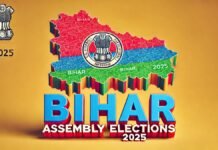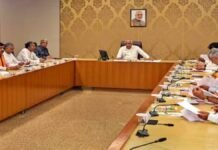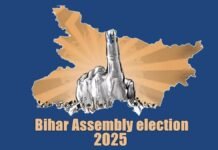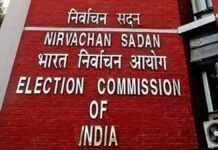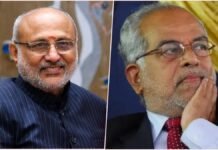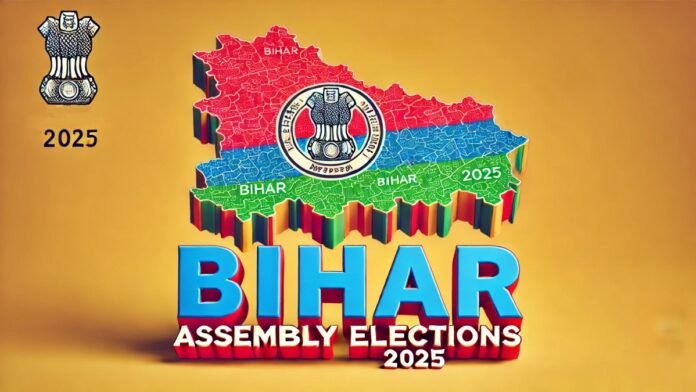
Key Points:
- JVC opinion poll (August-September 2025) projects NDA winning 131-150 seats vs Grand Alliance’s 81-103 seats in 243-member Bihar Assembly
- JDU expected to win 53 seats (10 more than 2020), BJP 66-77 seats, RJD 57-71 seats; Congress faces humiliation with just 11-14 seats
- Nitish Kumar leads CM race with 27% support, followed by Tejashwi Yadav (25%), Prashant Kishor (15%), Chirag Paswan (11%)
- Rahul Gandhi’s “vote theft” allegations rejected by 52% voters as baseless; his August-September Bihar tour fails to resonate
- Prashant Kishor’s Jan Suraaj Party projected to win 4-6 seats with 10-11% vote share, emerging as potential X-factor
- Election Commission released final voter list with 7.42 crore voters on September 29; elections expected in October-November 2025
- NDA projected 41-45% vote share vs Grand Alliance’s 37-40%; BJP-RJD locked in close race at 71-74 seats each
New Delhi: A major opinion poll conducted by JVC between August 16 and September 3, 2025, has delivered a shocking verdict ahead of Bihar’s assembly elections scheduled for October-November this year. The survey projects the ruling National Democratic Alliance (NDA) securing a comfortable majority with 131-150 seats in the 243-member Bihar Legislative Assembly, while the opposition Grand Alliance (Mahagathbandhan) is expected to be relegated to 81-103 seats.
According to the JVC Bihar Elections 2025 opinion poll, the Bharatiya Janata Party (BJP) is projected to win 66-77 seats, positioning itself as the largest party within the NDA coalition. The Janata Dal (United), led by current Chief Minister Nitish Kumar, is expected to secure 52-58 seats a remarkable gain of approximately 10 seats compared to the 2020 assembly elections when JDU won 43 seats. Other NDA allies including Lok Janshakti Party (Ram Vilas) and Hindustani Awam Morcha are projected to collectively win 13-15 seats.
The survey findings represent a significant boost for Nitish Kumar, whose political fortunes have been the subject of intense speculation following his dramatic flip-flops between alliances. After breaking with the BJP in August 2022 to form government with RJD, and then switching back to NDA in January 2024, many political analysts had written off JDU’s electoral prospects. The JVC poll contradicts those predictions, suggesting Kumar’s party may actually strengthen its position.
Grand Alliance Faces “Maha Tension” Amid Seat Crunch
The opposition Grand Alliance comprising the Rashtriya Janata Dal (RJD), Congress, Left parties, and Vikassheel Insaan Party (VIP) confronts a troubling scenario according to the JVC survey. The RJD, which emerged as the single-largest party with 75 seats in 2020, is now projected to win only 57-71 seats a potential decline of 4-18 seats.
The survey delivers a devastating blow to the Indian National Congress, projecting the grand old party to secure a mere 11-14 seats in Bihar. This would represent the party’s worst-ever performance in Bihar assembly elections, even worse than its dismal showing in 2020 when Congress won 19 seats. The continued electoral marginalization of Congress in Bihar threatens to further diminish the party’s bargaining power within the INDIA bloc alliance.
Other Grand Alliance partners including Left parties and VIP are collectively projected to win 13-18 seats. The cumulative Grand Alliance tally of 81-103 seats would fall well short of the 122-seat majority mark required to form government in the 243-member assembly.
Rahul Gandhi’s Campaign Tour Backfires Spectacularly
The JVC poll reveals that Lok Sabha Opposition Leader Rahul Gandhi’s August-September tour of Bihar, where he launched scathing attacks on the JDU-BJP government while accompanied by RJD leader Tejashwi Yadav, has comprehensively failed to move voters. Gandhi’s central campaign theme centered on allegations of “vote theft” through the Election Commission’s controversial Special Intensive Revision (SIR) of electoral rolls.
According to the survey, 52 percent of Bihar voters dismissed Gandhi’s allegations as baseless, dealing a severe credibility blow to the Congress leader’s election interference claims. Despite Gandhi’s multi-day padyatra across Bihar districts and his vociferous criticism of the voter list revision process—which temporarily removed 65 lakh voters before claims and objections were processed—the majority of voters appear unconvinced by his narrative.
The Election Commission of India released the final voter list on September 29, 2025, with 7.42 crore eligible voters after completing the contentious SIR exercise. The EC firmly rejected Gandhi’s allegations, asking him to submit evidence under oath or apologize to the nation. The controversy surrounding the SIR—which required voters to submit specific documents and drew Supreme Court scrutiny—became a major flashpoint, but the JVC poll suggests it has not translated into electoral gains for the opposition.
Prashant Kishor’s Jan Suraaj Emerges as Wild Card
The JVC survey identifies Prashant Kishor’s Jan Suraaj Party as a potentially significant disruptor in Bihar’s electoral landscape. The newly formed party, which announced it would independently contest all 243 assembly constituencies without forming alliances, is projected to win 4-6 seats with a substantial 10-11 percent vote share.
Kishor, the former election strategist who orchestrated victories for multiple parties across India before launching his own political outfit, undertook an extensive padayatra across Bihar between October 2022 and October 2024, walking over 5,000 kilometers and visiting more than 5,500 villages. His Bihar Badlav Yatra generated significant grassroots engagement, and the party’s October 2024 launch rally at Gandhi Maidan in Patna drew substantial crowds.
In a recent NDTV interview on September 27, 2025, Kishor made bold predictions, claiming JDU would win fewer than 25 seats and that his Jan Suraaj party “will either be first or last, but there is no middle ground in this election.” While the JVC poll’s projections are far more modest than Kishor’s ambitious claims, his party’s double-digit vote share could prove decisive in close constituencies, potentially eating into both NDA and Grand Alliance vote banks.
The Jan Suraaj Party has positioned itself as an alternative to establishment politics, promising US-style primaries for candidate selection, the right to recall non-performing legislators, and ensuring 90% of candidates are first-time contestants. Whether Kishor’s governance-focused campaign can translate his personal credibility into electoral success remains the election’s most intriguing question.
BJP and RJD Locked in Tight Battle
One of the JVC survey’s most striking findings is the neck-and-neck projection for Bihar’s two largest parties. The BJP is expected to win 66-77 seats, while the RJD is projected to secure 57-71 seats putting both parties in a similar range despite being in opposing alliances. This represents a potential marginal decline for both parties compared to 2020, when BJP won 74 seats and RJD won 75 seats.
The close BJP-RJD contest underscores Bihar’s continued political fluidity, where caste arithmetic, alliance dynamics, and local factors can swing constituencies in unpredictable directions. Both parties have invested heavily in digital campaigning alongside traditional ground mobilization—RJD’s social media team has produced viral AI-generated videos mocking rivals, while BJP has deployed extensive WhatsApp group networks and door-to-door campaigns through women vistaraks (extension workers).
Nitish Kumar Leads Chief Ministerial Race
Perhaps the most significant personal vindication in the JVC poll comes for 73-year-old Nitish Kumar, who emerges as the clear frontrunner for Chief Minister with 27 percent voter preference. This represents a remarkable political comeback for a leader who has faced relentless criticism for his alliance switches and whose advanced age has fueled speculation about his political decline.
RJD’s Tejashwi Yadav, the 36-year-old Deputy Chief Minister during the 2022-2024 Mahagathbandhan government, comes in second with 25 percent support just 2 percentage points behind Kumar. Yadav has positioned himself as the young face of change, running a digitally-savvy campaign focused on youth employment and backwards caste mobilization. His promise of massive job creation and his criticism of “institutionalized corruption” under Nitish Kumar’s governance have resonated with younger voters, though evidently not enough to overtake Kumar’s entrenched support base.
Prashant Kishor ranks third with 15 percent CM preference, remarkable for a first-time candidate without established party infrastructure. This underscores his personal appeal built through two years of grassroots engagement. LJP(R) leader Chirag Paswan, who has publicly backed Nitish Kumar as NDA’s CM face, secures 11 percent support, while BJP’s Samrat Chaudhary trails at 8 percent.
Vote Share Projections and Regional Factors
In terms of aggregate vote share, the JVC survey projects the NDA securing 41-45 percent of votes cast, compared to the Grand Alliance’s 37-40 percent. This 4-5 percentage point gap, while not insurmountable, translates into a more substantial seat differential due to India’s first-past-the-post electoral system where even narrow vote margins can produce decisive seat advantages.
The survey’s findings of JDU gaining 10 additional seats compared to 2020—rising from 43 to approximately 53—appears particularly significant in August polling context. An earlier survey conducted in August 2025 had projected JDU winning only around 26-27 seats, meaning the party’s prospects have nearly doubled in just one month. This dramatic reversal suggests either significant ground-level momentum for Nitish Kumar or potential volatility in voter sentiment as election day approaches.
Campaign Dynamics and Key Issues
The 2025 Bihar assembly election campaign has centered on several interconnected themes. Unemployment and youth migration remain paramount concerns—millions of Bihar’s youth migrate annually to other states for work, and all parties have promised large-scale job creation. Tejashwi Yadav’s signature promise of government jobs has been countered by NDA’s emphasis on entrepreneurship and infrastructure development.
Caste politics continues to dominate Bihar’s electoral landscape. All major parties have pledged support for a comprehensive caste census and “social justice” measures, reflecting widespread demands to address the state’s entrenched caste-based inequalities. RJD has organized extensive backwards caste conventions, while BJP-JDU have deployed targeted welfare outreach to specific caste communities.
Governance and corruption have emerged as flashpoint issues. Tejashwi Yadav has accused the Nitish Kumar government of “institutionalizing corruption” and misusing government schemes for electoral purposes. The NDA has countered by invoking the “jungle raj” (lawlessness) that allegedly prevailed during RJD’s previous tenures and highlighting their welfare delivery record.
Electoral Roll Controversy Dominates Discourse
The Election Commission’s Special Intensive Revision of electoral rolls became the campaign’s most contentious controversy. The June 2025 notification requiring all Bihar voters to re-register with specific documents excluding common identity proofs like Aadhaar cards, voter IDs, and ration cards—triggered massive opposition protests.
When the initial process removed 65 lakh voters (6.5 million names) from Bihar’s electoral rolls, opposition parties alleged systematic disenfranchisement targeting minorities and migrant workers. The matter reached the Supreme Court, which suggested the EC accept standard identity documents. The EC rejected this advice, maintaining its documentary requirements were legally sound.
After a claims and objections period, the final voter list published September 29, 2025, includes 7.42 crore voters down from the pre-SIR count of 7.89 crore. While 21.53 lakh new voters were added and some deleted names were restored, the net reduction of approximately 47 lakh voters remains controversial. Opposition leaders, including Tejashwi Yadav, claimed their own names were removed, though the EC termed such allegations factually incorrect and challenged leaders to submit fake voter IDs they displayed.
Despite this controversy becoming central to Rahul Gandhi’s Bihar campaign, the JVC poll suggests voters have not bought the “vote theft” narrative, with 52 percent dismissing it as baseless.
Path to Victory and Coalition Mathematics
For the NDA to form government, the alliance’s projected 131-150 seats would comfortably exceed the 122-seat majority threshold. The coalition’s demonstrated cohesion—with Chirag Paswan publicly endorsing Nitish Kumar as CM and BJP-JDU negotiating a near-equal seat-sharing formula—provides organizational clarity heading into elections.
The Grand Alliance’s projected 81-103 seats would fall significantly short of majority, requiring post-poll alliances to form government. The possibility of Prashant Kishor’s Jan Suraaj Party holding 4-6 seats could theoretically make it a kingmaker in a hung assembly scenario, though the JVC projections suggest a clear NDA victory that would render such calculations moot.
For Congress, the projected 11-14 seats represent an existential crisis in a state where the party was once dominant. The stark contrast between Congress’s decline and JDU’s resurgence illustrates how regional parties with strong local leadership have displaced national parties in Bihar’s political landscape.
Election Timeline and Next Steps
The Election Commission of India is expected to announce the complete election schedule for Bihar in early October 2025, with polling anticipated in October or November 2025. The notification will trigger the formal campaign period, model code of conduct implementation, and final candidate nominations.
Prime Minister Narendra Modi has already held mega rallies in Motihari and Siwan, announcing infrastructure projects worth thousands of crores. BJP’s extensive campaign machinery combined with JDU’s organizational network and LJP(R)’s Paswan community base provides the NDA with formidable ground-level reach.
The Grand Alliance faces the challenge of converting anti-incumbency sentiment into votes despite the JVC poll suggesting current momentum favors the NDA. Whether Tejashwi Yadav’s youth-focused digital campaign and backwards caste mobilization can overcome the survey’s pessimistic projections remains to be seen.
As Bihar heads toward elections in the coming weeks, the JVC opinion poll has set expectations and battle lines. Whether these projections hold or whether ground realities shift dramatically before polling day will determine whether Nitish Kumar secures yet another term as Chief Minister or whether Bihar opts for generational political change under Tejashwi Yadav’s leadership.















